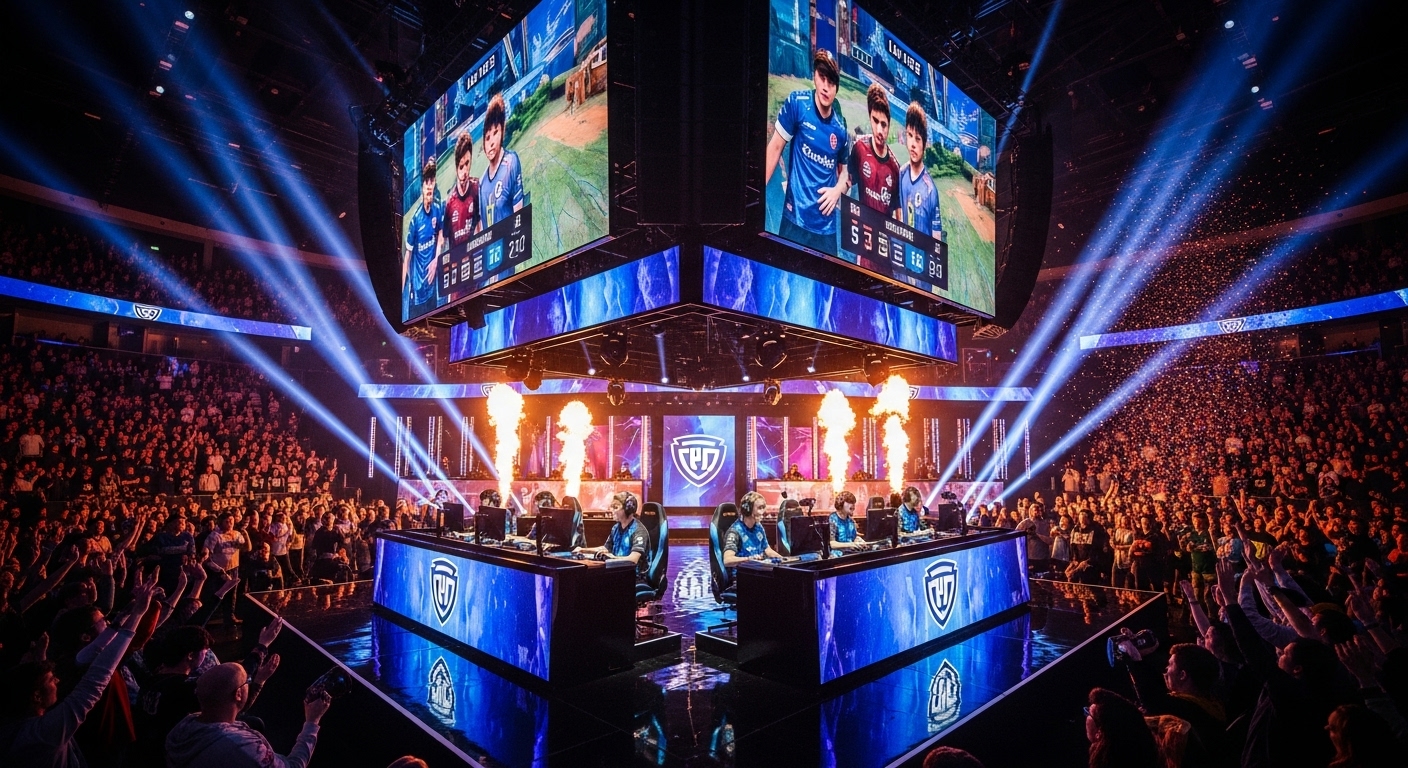Esports, short for electronic sports, has grown from a niche hobby into a global phenomenon. What began as casual competitions among friends and arcade tournaments has evolved into a multibillion-dollar industry with professional teams, international tournaments, and millions of fans worldwide. The rise of esports represents not only technological advancements but also a cultural shift in how people perceive gaming as a legitimate form of competition and entertainment.
In this blog, we explore the history, development, cultural impact, business aspects, and future prospects of esports, providing a comprehensive look at this rapidly growing industry.
Early Beginnings of Competitive Gaming
Competitive gaming dates back to the 1970s and 1980s, when arcade machines and early home consoles began capturing the imagination of players worldwide. One of the first known esports events was the 1972 “Intergalactic Spacewar Olympics,” held at Stanford University, which celebrated the game Spacewar!
Arcade tournaments in the 1980s, including competitions for Pac-Man and Donkey Kong, were the precursors to organized esports. These events were limited in scale but demonstrated the appeal of skill-based competition in gaming. High scores and leaderboard rankings created a sense of community and rivalry that would later become central to esports culture.
The Birth of Modern Esports
The 1990s marked a turning point in competitive gaming. The widespread adoption of personal computers, the rise of LAN (Local Area Network) parties, and early online connectivity enabled players to compete on a larger scale. Games such as Quake, StarCraft, and Counter-Strike became staples of competitive gaming.
StarCraft, in particular, became a cultural phenomenon in South Korea, where professional leagues and televised matches popularized esports as a career path. By the late 1990s, South Korea had established the infrastructure, fan base, and corporate sponsorships necessary for esports to thrive, setting a model that would influence global markets.
The Role of Technology in Esports Growth
Technology has played a crucial role in the growth of esports. High-speed internet, streaming platforms, and powerful gaming hardware have made competitive gaming accessible to millions worldwide.
Streaming platforms like Twitch, YouTube Gaming, and later Facebook Gaming allowed audiences to watch matches live, interact with players, and engage with communities. This not only increased the visibility of esports but also created new revenue streams through advertisements, subscriptions, and donations.
Advanced hardware, including high-refresh-rate monitors, gaming mice, and keyboards, has allowed professional players to push the limits of skill and precision. Meanwhile, software innovations, including spectator modes and replay systems, have enhanced the viewing experience, making esports more enjoyable for fans.
Popular Esports Titles and Their Impact
Several games have played pivotal roles in shaping the esports landscape. Each title introduced unique gameplay mechanics, competitive formats, and community cultures.
1. League of Legends
Released in 2009, League of Legends (LoL) became one of the most popular and influential esports titles. Its multiplayer online battle arena (MOBA) format emphasizes team coordination, strategy, and individual skill. The game’s professional league system, the League of Legends Championship Series (LCS) and Worlds Championship, has attracted millions of viewers worldwide.
2. Counter-Strike: Global Offensive
Counter-Strike and its iterations, particularly CS:GO, have been central to esports for decades. The game’s tactical first-person shooter mechanics reward precision, communication, and strategic thinking. Its professional tournaments, including the Majors, continue to draw significant audiences and prize pools.
3. Dota 2
Valve’s Dota 2 popularized esports with The International, an annual tournament featuring record-breaking prize pools. Its complex gameplay, deep strategy, and team-based competition have made it a cornerstone of competitive gaming.
4. Fortnite
Fortnite brought a new dimension to esports by combining battle royale mechanics with building and creativity. Its global tournaments, such as the Fortnite World Cup, demonstrated that esports could reach younger audiences and mainstream culture simultaneously.
5. Overwatch
Blizzard Entertainment’s Overwatch introduced a team-based shooter with distinct hero roles, emphasizing coordination and strategy. The Overwatch League set new standards for franchised esports competitions, including city-based teams and global broadcast partnerships.
These titles, among others, highlight the diversity of esports and the range of skills, strategies, and audience engagement that define the industry.
The Business of Esports
Esports has evolved into a significant economic ecosystem. Revenue streams include sponsorships, advertising, merchandise sales, ticketed events, streaming platforms, and in-game purchases.
Professional esports teams operate much like traditional sports franchises. They recruit talent, provide coaching, and negotiate sponsorships. Global brands, from technology companies to consumer products, invest in esports sponsorships to reach younger, tech-savvy audiences.
Prize pools for top tournaments have grown exponentially. Events like The International in Dota 2 offer tens of millions of dollars in total prize money, rivaling traditional sports tournaments. This financial growth has attracted professional players, investors, and mainstream media attention.
The Cultural Impact of Esports
Esports has influenced global culture in several ways.
Community and Social Connection
Esports creates communities where fans and players interact, share experiences, and form friendships. Online forums, Discord servers, and live chat interactions foster engagement and a sense of belonging.
Mainstream Recognition
Esports athletes now enjoy recognition similar to traditional sports stars. Players gain celebrity status, appear in media, and influence fashion, gaming culture, and youth trends.
Education and Career Opportunities
Esports has opened new career paths, including professional player, coach, commentator, analyst, and event organizer. Universities worldwide have started offering scholarships and programs in esports management, game design, and sports psychology.
Media and Entertainment Integration
Esports has become a content hub for streaming platforms, television networks, and social media. Collaborations with music, entertainment, and mainstream sports events expand its reach and influence.
Health and Lifestyle Considerations
Professional esports requires high levels of skill and practice, but it also demands attention to physical and mental health. Players often spend long hours practicing, which can lead to fatigue, stress, and musculoskeletal problems.
Teams now employ trainers, nutritionists, and mental health professionals to maintain player well-being. Proper sleep, exercise, diet, and mindfulness practices are emphasized to sustain peak performance. These measures highlight the importance of balancing intense training with health-conscious routines.
Esports Governance and Regulation
As esports grows, regulation becomes increasingly important. Organizations such as the Esports Integrity Commission (ESIC) and various regional bodies oversee fair play, anti-doping measures, and ethical standards.
Professional leagues implement rules to prevent cheating, match-fixing, and exploitation of players. Governance ensures that esports maintains credibility and integrity, which is essential for attracting sponsors, audiences, and mainstream recognition.
The Global Expansion of Esports
While early esports dominance was concentrated in South Korea, the industry is now truly global. North America, Europe, China, Southeast Asia, and South America all host thriving esports ecosystems.
Government support, infrastructure development, and local tournaments contribute to regional growth. In some countries, esports is recognized as a professional sport, with players receiving visas, sponsorships, and career opportunities comparable to traditional athletes.
This global expansion has also created cross-cultural exchange, bringing together players and fans from diverse backgrounds, further enriching the esports community.
Challenges Facing Esports
Despite its rapid growth, esports faces several challenges.
Player Burnout
High-pressure environments and intensive practice schedules can lead to burnout, affecting performance and mental health. Teams must balance training intensity with rest and recovery.
Inclusivity and Diversity
Esports struggles with gender diversity, representation, and inclusivity. Initiatives promoting equality and combating harassment are critical for creating safe and welcoming communities.
Monetization and Fairness
While revenue has grown, ensuring fair monetization for players, teams, and developers remains a challenge. Transparency in contracts, sponsorship deals, and revenue sharing is essential for sustainability.
Public Perception
Some audiences still view esports as “just video games.” Changing perceptions to recognize skill, strategy, and athleticism is ongoing but essential for mainstream legitimacy.
The Future of Esports
The future of esports is promising, driven by technology, global expansion, and cultural integration.
Virtual Reality and Immersive Experiences
VR and AR technologies have the potential to revolutionize esports, offering fully immersive competitive experiences and new ways to engage audiences.
Mobile Esports
Mobile gaming is increasingly popular, especially in regions where consoles and PCs are less accessible. Titles like PUBG Mobile and Mobile Legends demonstrate the global reach and profitability of mobile esports.
Cross-Platform and Global Leagues
Cross-platform play allows players on different devices to compete together, increasing accessibility and community engagement. Global leagues are expected to expand, connecting players and fans worldwide.
Integration with Traditional Sports
Esports partnerships with traditional sports franchises are growing, combining fanbases and creating hybrid entertainment models. Teams from football, basketball, and racing leagues now operate esports divisions, further legitimizing the industry.
Conclusion
Esports has transformed from a small, niche hobby into a global entertainment and competitive powerhouse. Its rise is fueled by technological innovation, compelling games, skilled players, and a passionate fan base. Beyond competition, esports has cultural, social, and economic significance, creating communities, career opportunities, and entertainment experiences for millions worldwide.
While challenges exist, including health considerations, inclusivity, and public perception, the industry continues to innovate and adapt. Responsible practices, governance, and technological advancements ensure that esports remains sustainable and credible.
The future of esports is bright, with immersive technologies, global expansion, and professionalization poised to redefine the boundaries of competition and entertainment. As esports continues to grow, it will remain not only a form of gaming but also a cultural phenomenon that connects people across the globe, inspires new generations, and transforms the way we experience digital competition.
Esports is more than a game—it is a movement, a career path, a spectacle, and a symbol of how technology and human creativity can unite to redefine entertainment for the 21st century.



